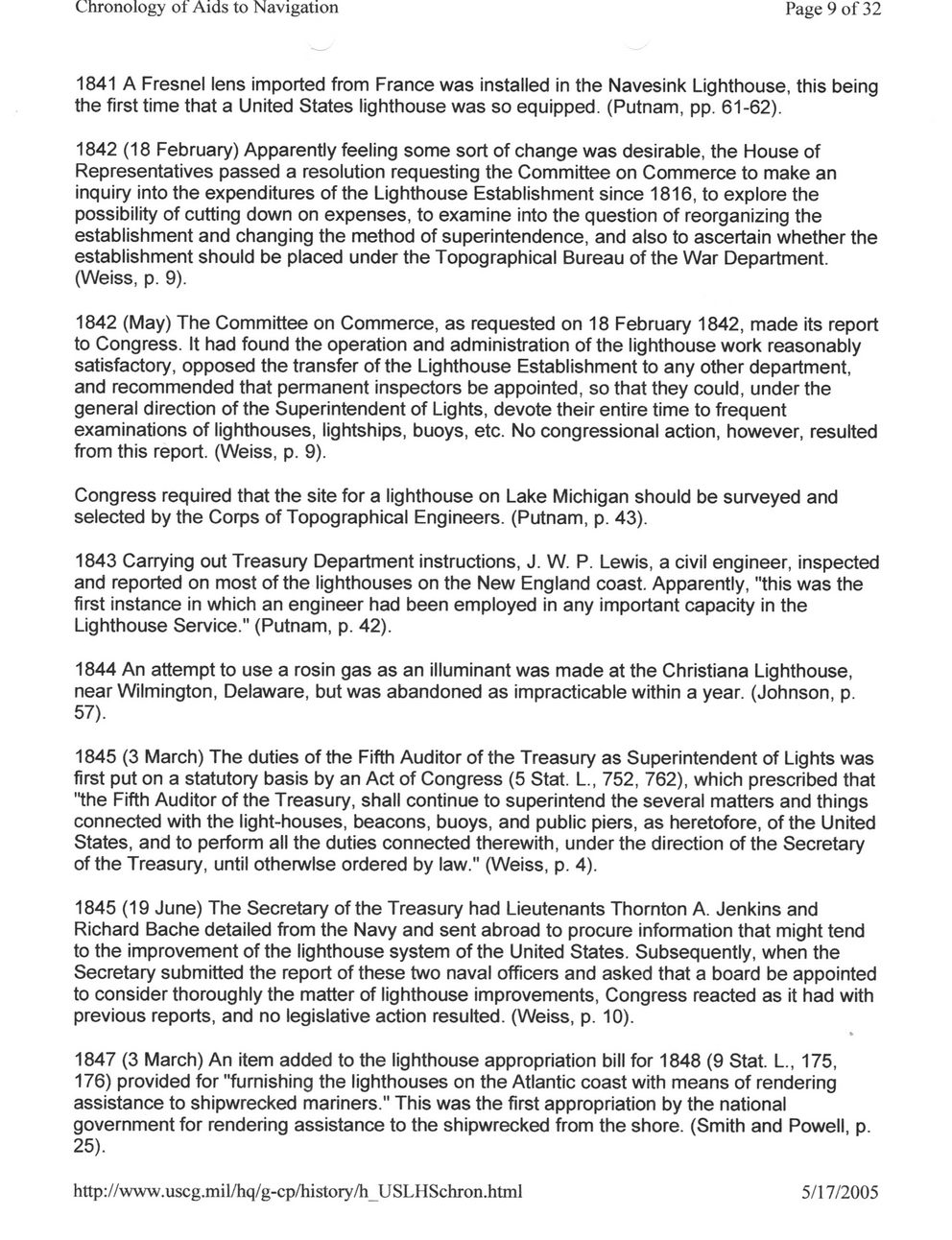This text was obtained via automated optical character recognition.
It has not been edited and may therefore contain several errors.
Chronology of Aids to Navigation Page 9 of 32 1841 A Fresnel lens imported from France was installed in the Navesink Lighthouse, this being the first time that a United States lighthouse was so equipped. (Putnam, pp. 61-62). 1842 (18 February) Apparently feeling some sort of change was desirable, the House of Representatives passed a resolution requesting the Committee on Commerce to make an inquiry into the expenditures of the Lighthouse Establishment since 1816, to explore the possibility of cutting down on expenses, to examine into the question of reorganizing the establishment and changing the method of superintendence, and also to ascertain whether the establishment should be placed under the Topographical Bureau of the War Department. (Weiss, p. 9). 1842 (May) The Committee on Commerce, as requested on 18 February 1842, made its report to Congress. It had found the operation and administration of the lighthouse work reasonably satisfactory, opposed the transfer of the Lighthouse Establishment to any other department, and recommended that permanent inspectors be appointed, so that they could, under the general direction of the Superintendent of Lights, devote their entire time to frequent examinations of lighthouses, lightships, buoys, etc. No congressional action, however, resulted from this report. (Weiss, p. 9). Congress required that the site for a lighthouse on Lake Michigan should be surveyed and selected by the Corps of Topographical Engineers. (Putnam, p. 43). 1843 Carrying out Treasury Department instructions, J. W. P. Lewis, a civil engineer, inspected and reported on most of the lighthouses on the New England coast. Apparently, "this was the first instance in which an engineer had been employed in any important capacity in the Lighthouse Service." (Putnam, p. 42). 1844 An attempt to use a rosin gas as an illuminant was made at the Christiana Lighthouse, near Wilmington, Delaware, but was abandoned as impracticable within a year. (Johnson, p. 57). 1845 (3 March) The duties of the Fifth Auditor of the Treasury as Superintendent of Lights was first put on a statutory basis by an Act of Congress (5 Stat. L., 752, 762), which prescribed that "the Fifth Auditor of the Treasury, shall continue to superintend the several matters and things connected with the light-houses, beacons, buoys, and public piers, as heretofore, of the United States, and to perform all the duties connected therewith, under the direction of the Secretary of the Treasury, until otherwise ordered by law." (Weiss, p. 4). 1845 (19 June) The Secretary of the Treasury had Lieutenants Thornton A. Jenkins and Richard Bache detailed from the Navy and sent abroad to procure information that might tend to the improvement of the lighthouse system of the United States. Subsequently, when the Secretary submitted the report of these two naval officers and asked that a board be appointed to consider thoroughly the matter of lighthouse improvements, Congress reacted as it had with previous reports, and no legislative action resulted. (Weiss, p. 10). » 1847 (3 March) An item added to the lighthouse appropriation bill for 1848 (9 Stat. L., 175, 176) provided for "furnishing the lighthouses on the Atlantic coast with means of rendering assistance to shipwrecked mariners." This was the first appropriation by the national government for rendering assistance to the shipwrecked from the shore. (Smith and Powell, p. 25). http://www.uscg.mil/hq/g-cp/history/h_USLHSchron.html 5/17/2005

Lighthouses Chronology-of-Aids-to-Navigation-(09)